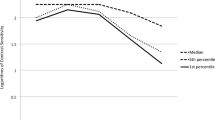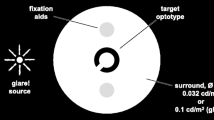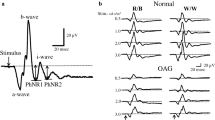Abstract
Contrast sensitivity testing has been recommended as a more sensitive indicator of early visual loss than visual field testing. Using gravity inversion to induce an intraocular pressure rise, we performed contrast sensitivity testing on each eye of 10 normal subjects in the upright and inverted positions. Contrast sensitivity results were not altered in the head-down position, even though in 5 of the 10 subjects (7 of 20 eyes), visual field alterations on static perimetry were elicited during inversion. In both of these evaluations, the subject's results in the upright position served as the control, freeing us from reliance upon age-matched populations. We conclude that precise measurement of static thresholds with automated perimetry is more sensitive than routine contrast sensitivity testing in detecting visual dysfunction related to transient acute elevations of intraocular pressure.
Similar content being viewed by others
References
Adams AJ, Heron G, Husted R (1987) Clinical measures of central visual function in glaucoma and ocular hypertension. Arch Ophthalmol 105: 782–787
Caprioli J, Spaeth GL (1985) Static threshold examination of the peripheral nasal visual field in glaucoma. Arch Ophthalmol 103: 1150–1154
Friberg TR, Sanborn G (1985) Optic nerve dysfunction during gravity inversion. Arch Opthalmol 103: 1687–1689
Friberg TR, Weinreb RN (1985) Ocular manifestatioans of gravity inversion. JAMA 253: 1755–1757
Linder BJ, Trick GL, Cooper DG, Applegate RA (1987) Dissociation of color vision and contrast sensitivity deficits in glaucoma suspects. Invest Ophthalmol Vis Sci [Suppl] 28: 62
Ross JE (1985) Clinical detection of abnormalities in central vision in chronic simple glaucoma. Int Ophthalmol 8: 167–177
Ross JE, Bron AJ, Reeves BC, Emmerson PG (1985) Detection of optic nerve damage in ocular hypertension. Br J Ophthalmol 69: 897–903
Ross JE, Clarke DD, Bron AJ (1985) Effect of age on contrast sensitivity function: uniocular and binocular findings. Br J Ophthalmol 69: 51–56
Sanborn GE, Friberg TR, Allen R (1987) Optic nerve dysfunction during gravity inversion. Visual field abnormalities. Arch Ophthalmol 105: 774–776
Weinreb RN, Cook J, Friberg TR (1984) Effect of inverted body position on intraocular pressure. Am J Ophthalmol 98: 784–787
Whalen WR (1985) Routine reliability parameters in Whalen WR, Spaeth GL (eds) Computerized visual fields. What they are and how to use them. Slack, New Jersey, pp 81–88
Author information
Authors and Affiliations
Rights and permissions
About this article
Cite this article
Friberg, T.R., Sanborn, G.E. & Budd, R. Contrast sensitivity versus static visual field testing during experimental elevation of intraocular pressure. Graefe's Arch Clin Exp Ophthalmol 227, 345–347 (1989). https://doi.org/10.1007/BF02169410
Received:
Accepted:
Issue Date:
DOI: https://doi.org/10.1007/BF02169410




